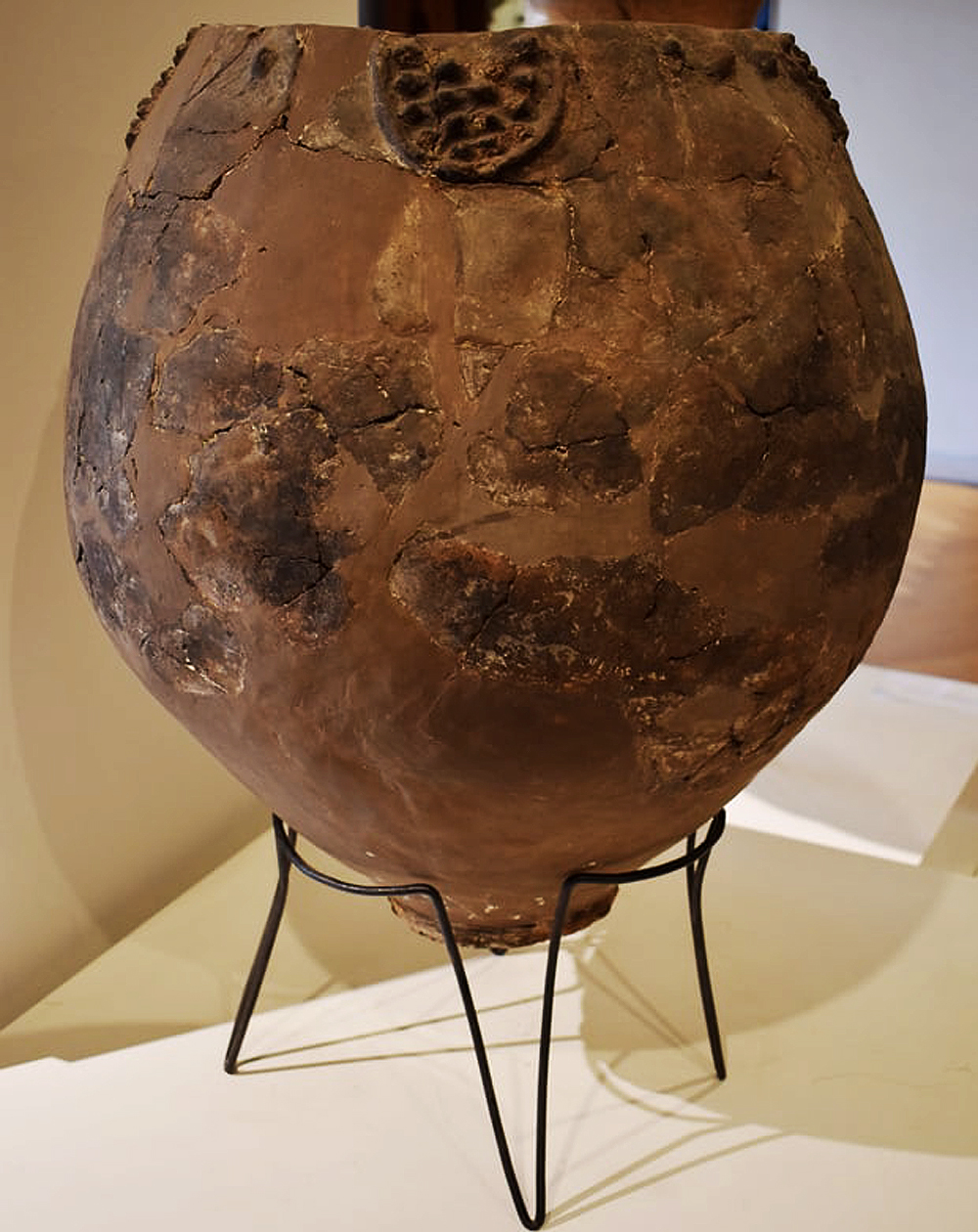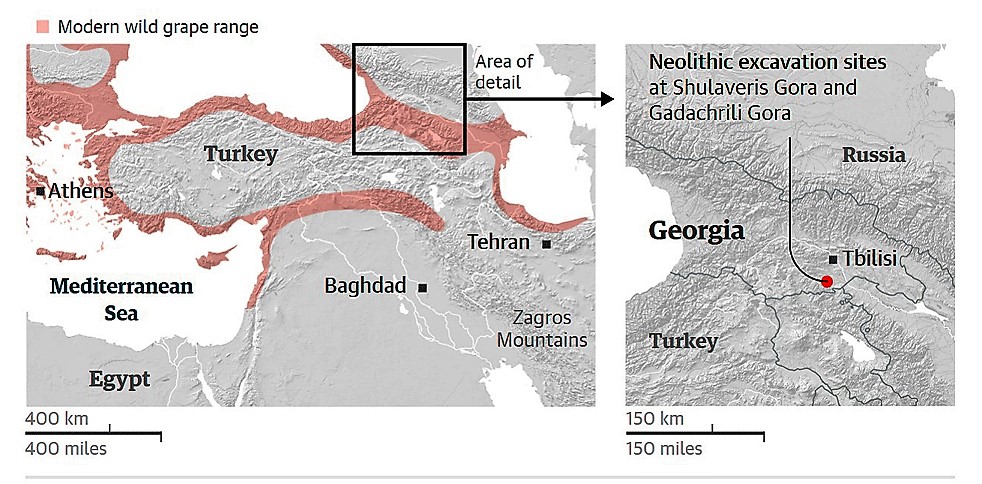


Earliest winemaking in Georgia
|
An article by Ashifa Kassam and Nicola Davis on guardian.com - Evidence of world's earliest winemaking uncovered by archaeologists - reports that analysis of clay pottery dating back to 6,000 BC reveals humans made grape wine hundreds of years earlier than previously believed.

A neolithic jar – possibly a qvevri, used for fermenting wine – from the site of Khramis Didi Gora, on display at the Georgian National Museum. Photograph: Judyta Olszewski/PA.
A series of excavations in Georgia has uncovered evidence of the world's earliest winemaking, in the form of telltale traces within clay pottery dating back to 6,000BC - suggesting that the practice of making grape wine began hundreds of years earlier than previously believed.

Earliest evidence of winemaking found in Georgia. Image: Guardian graphic. University of Toronto & University of Pennsylvania.
While there are thousands of cultivars of wine around the world, almost all derive from just one species of grape, with the Eurasian grape the only species ever domesticated.
Until now, the oldest jars known to have contained wine dated from 7,000 years ago, with six vessels containing the chemical traces of wine discovered in the Zagros mountains in northern Iran in 1968.
This latest discovery suggests wine making goes back at least 8,000 years, according to Patrick McGovern, a co-author of the study from the University of Pennsylvania museum of archaeology and anthropology, who also worked on the earlier Iranian discovery.
Earliest winemaking in Georgia https://t.co/BZYoF9Jwrq #Neolithic #archaeology #wine pic.twitter.com/57Ptkqr9VA
— Bradshaw Foundation (@BradshawFND) November 16, 2017
A drone photograph of excavations at the Gadachrili Gora, Georgia. Image: Stephen Batiuk.
The find comes after a team of archaeologists and botanists in Georgia began working with researchers in Europe and North America to explore two villages in the South Caucasus region, about 50km south of the capital Tbilisi. The sites offered a glimpse into a Neolithic culture characterised by circular mud-brick homes, tools made of stone and bone and the farming of cattle, pigs, wheat and barley.
Significantly, researchers found fired clay pots, likely to be some of the earliest pottery made in the Near East. One is almost a metre tall and a metre wide, and could hold more than 300 litres. It was decorated with blobs which the researchers believe may have depicted clusters of grapes.
The team focused on collecting and analysing fragments of pottery from two Neolithic villages, as well as soil samples. Radiocarbon dating of grains and charcoal nearby suggested the pots date to about 6,000 to 5,800 BC.
In total, 30 pottery fragments and 26 soil samples were examined, with the inside surface of the pottery ground down a little to produce a powder for analysis. The team then used a variety of analytical techniques to explore whether the soil or the inner surface of the vessels held signs of molecules of the correct mass, or with the right chemical signatures, to be evidence of wine.
The results, published in the Proceeding of the National Academy of Sciences, reveal that for eight of the fragments there were traces of tartaric acid - a substance found in grapes in large quantities. Tests on the associated soils largely showed far lower levels of the acid. The team also identified the presence of three other acids linked to grapes and wine. Other evidence indicating the presence of wine included ancient grape pollen found at the excavated sites - but not in the topsoil - as well as grape starch particles, the remains of a fruit fly, and cells believed to be from the surface of grapevines on the inside of one of the fragments.
The team admit that it is possible the vessels were used to store something other than wine, such as the grapes themselves, but they suggest that the shape of the vessels is suited to holding a liquid and that grapes or raisins would have degraded without trace. Moreover, there are no signs of syrup-making, while grape juice would have fermented within a matter of days.
Thus the sites were home to some of the earliest known vintners. Older remnants of winemaking have also been found at the Jiahu site in China's Henan province, dating back to 7,000BC, but the fermented liquid appeared to be a mixture of grapes, hawthorn fruit, rice beer and honey mead.
With their narrow base, the large clay pots used do not stand up easily, suggesting they might have been half buried in the ground during the winemaking process, as was the case for the Iranian vessels and which is a traditional practice still used by some in Georgia.
Davide Tanasi, of the University of South Florida, states that the findings point to an example of the oldest pure grape wine in the world. The results of the excavations, largely sponsored by the National Wine Agency of Georgia, are being well received: "They have been saying for years that they have a very long history of winemaking".
COMMENTS |
|











